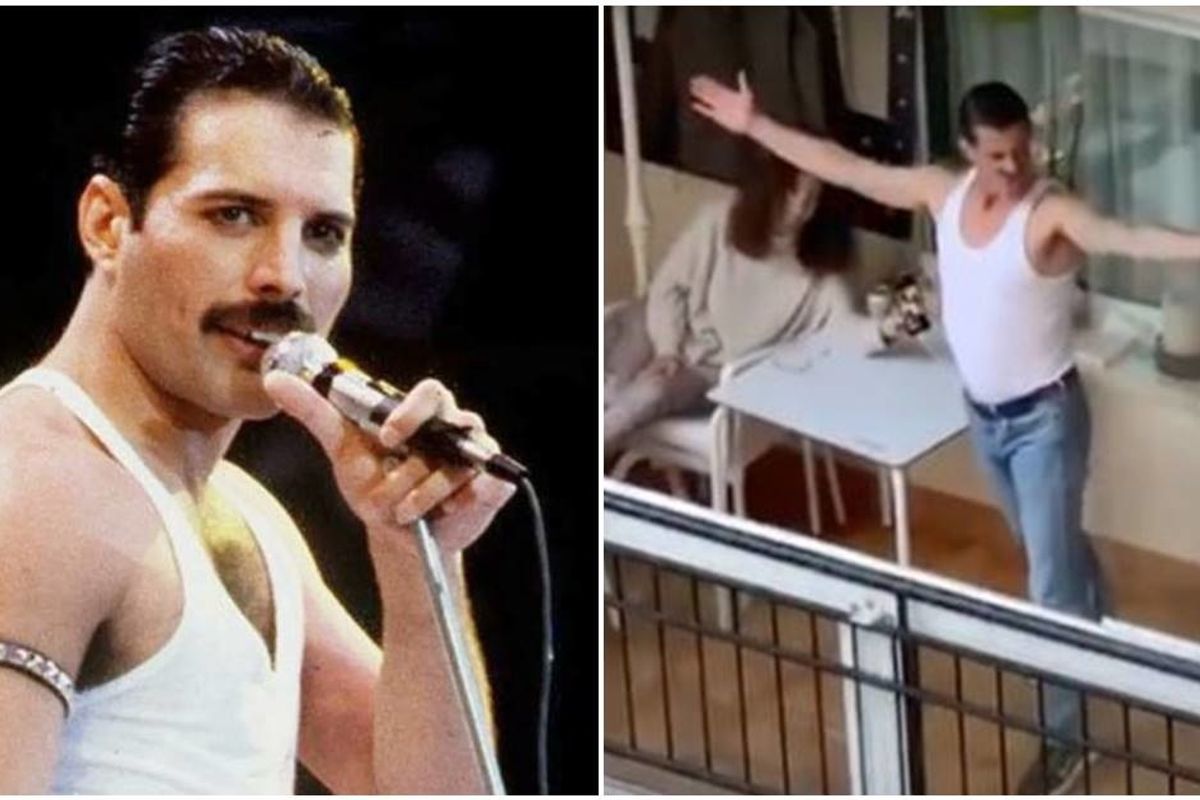When Autumn de Forest was five years old, she picked up a paintbrush for the first time. It wasn't long before she was ready to show the world what she could do.
After a year of practice, the then-six-year-old asked her father if he could get her a booth at a local art-in-the-park program. "People would come up to the booth, and they would talk to my father, and they'd say, 'This is great!'" she said. "Apparently they thought it was Take Your Daughter to Work Day."
Almost everyone thought the artwork was her father's. When they found out that tiny Autumn was the artist, people couldn't believe their eyes.
 Autumn created this piece when she was just 5 years old.Autumn de Forest
Autumn created this piece when she was just 5 years old.Autumn de Forest
Soon, Autumn rose to national fame
When Autumn was eight, she was featured on the Discovery Health Channel. There was a slew of media attention in the years that followed. There was Disney. There was The Today Show. There was Wendy Williams. She was called a child genius, a prodigy, and an expert painter.
- YouTube www.youtube.com
Suddenly, Autumn de Forest was everywhere.
But not everyone was so accepting of the young artist and her work. Some people in the art world had...questions. Sure, she was good for a kid. But was her art actually good? Others wondered if the whole thing might be an elaborate hoax.
Autumn ignored her critics and kept painting.
By age 14, she developed a startlingly organized daily routine that went far beyond a 9 to 5
Somehow, as the focus on her age began to wear off, Autumn's work ethic and art only grow stronger. She said that most days, she'd wake up in her parents' Las Vegas home at 7:30 a.m. After breakfast, she'd break out her supplies for a one- or two-hour painting session. From there, she dove into her school work. Most brick-and-mortar schools can't accommodate her travel schedule, so she did the majority of her schooling online.
Before dinner, it was back into the studio.
"That session can last much longer, that can be three or four hours when I really get into it," she said. "Then I probably have dinner and go to bed."
 Autumn de Forest paints Autumn de Forest
Autumn de Forest paints Autumn de Forest
The results speak for themselves
Her work has been displayed in galleries and exhibitions all over the world.
 An Autumn de Forest paintingAutumn de Forest
An Autumn de Forest paintingAutumn de Forest
Autumn held a public demonstration before a showing at The Butler Institute of American Art.
 assets.rebelmouse.io
assets.rebelmouse.io
The award took her to the Vatican for a private showing of her artwork with Pope Francis.
 Autumn de Forest stands with the Pope who looks at one of her paintings Autumn de Forest
Autumn de Forest stands with the Pope who looks at one of her paintings Autumn de Forest
At 16, she also worked with the President's Committee on the Arts and the Humanities, headed up by former First Lady Michelle Obama.
As part of the program, de Forest traveled to underprivileged schools around the country and led painting workshops. Oh, and if you're looking for some hard numbers to attach to Autumn's talent, she's got those, too.
Her paintings raked in over $7 million at auctions by the time she was a teenager—fetching as much as $25,000 each—much of which has gone directly to charities and disaster relief funds.
Now 24, Autumn continues to be represented by Park West Gallery, the world's largest art dealer, and is keeping busy with her craft and philanthropy.
- YouTube youtu.be
The transition from child prodigy to respected artist has certainly kept her busy. In 2017, the Monthaven Arts and Cultural Center in Hendersonville, Tennessee hosted a major solo exhibition for de Forest titled "Her White Room: The Art of Autumn de Forest."
That same year, de Forest was listed as one of Teen Vogue's "21 Under 21." In her profile she was praised for her talent as well as her commitment to art education.
"In disadvantaged schools, they consider the arts an extracurricular activity," she told Teen Vogue. "It's devastating, as there could be child prodigies in these schools, but they don't know that they have this God-given gift because they're not given the opportunity because there's nearly no art programs in schools."
In 2018, de Forest was featured in the music video for the song "Youth" by best-selling recording artists Shawn Mendes and Khalid. The video highlights exceptional young people working to change the world, including de Forest, Emma González, and Elias and Zion Phoenix.
The video has over 88 million views on YouTube.
And of course, de Forest continues to share her absolutely incredible artwork on Instagram and in shows and exhibitions around the globe.
The Autumn de Forest Foundation helps her keep track of the kids she's met throughout the years and to continue to help them with their art careers
A portion of the foundation's money goes to a 529 account set up for the students while 10% goes to them directly.
"A lot of these kids that I work with, they're not very old, they're in second grade, third grade, fourth grade. Maybe in 10 years, they may only have four or five thousand dollars but that could be the difference between them going to college or not," Autumn told Teen Vogue.
Autumn's incredible rise in the art world is an astonishing feat for someone so young, but that accomplishment is easily matched by her generosity and commitment to helping develop tomorrow's prodigies as well.
De Forest's latest solo exhibition debuted in late August of this year, and ran through mi September at the Park West Soho Gallery. She now resides in Los Angeles according to her profile on the networking site, dot.cards.
For more information, visit her website.
This article originally appeared nine years ago. It has been updated.




 TikTok · Ale
TikTok · Ale
 Autumn created this piece when she was just 5 years old.Autumn de Forest
Autumn created this piece when she was just 5 years old.Autumn de Forest  Autumn de Forest paints Autumn de Forest
Autumn de Forest paints Autumn de Forest  An Autumn de Forest paintingAutumn de Forest
An Autumn de Forest paintingAutumn de Forest 
 Autumn de Forest stands with the Pope who looks at one of her paintings Autumn de Forest
Autumn de Forest stands with the Pope who looks at one of her paintings Autumn de Forest 
 A menacing man asks that you say his name.
A menacing man asks that you say his name.  Spider-Man dances like nobody's watching.
Spider-Man dances like nobody's watching. 

 Angelo and Jennifer were a happy couple.
Angelo and Jennifer were a happy couple. Angelo and Jennifer
Angelo and Jennifer  Jennifer was diagnosed with cancer in 2008.
Jennifer was diagnosed with cancer in 2008. Her diagnosis came only five months after they were married.
Her diagnosis came only five months after they were married. Losing hair is a common side effect of cancer treatment.
Losing hair is a common side effect of cancer treatment. Angelo and Jennifer decided to document her cancer journey.
Angelo and Jennifer decided to document her cancer journey. Cancer can be lonely sometimes.
Cancer can be lonely sometimes.  Not everyone understands the journey.
Not everyone understands the journey. They captured the ups and the downs.
They captured the ups and the downs.  They also captured the love and heartbreak.
They also captured the love and heartbreak. Small joys are part of the journey.
Small joys are part of the journey. Celebrating Jennifer's 40th birthday
Celebrating Jennifer's 40th birthday Having a support system makes a big difference.
Having a support system makes a big difference.  Every photo tells a story.
Every photo tells a story. There is love in every image.
There is love in every image. And then the after began.
And then the after began. Jennifer's tombstone reads "I loved it all."
Jennifer's tombstone reads "I loved it all." 